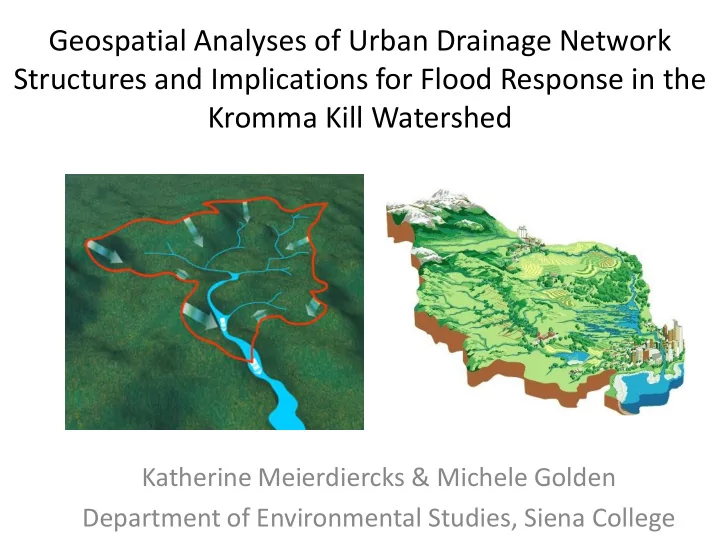

Geospatial Analyses of Urban Drainage Network Structures and Implications for Flood Response in the Kromma Kill Watershed Katherine Meierdiercks & Michele Golden Department of Environmental Studies, Siena College
LINEAR V. NON-LINEAR RESPONSE ALONG A DRAINAGE NETWORK ! "#"$% & ' () !* +,*- .!*/ / 0!1 23!' $4 5 !% 4 67829 #" ! !"!! # ! $ CD D, 2 !E7 ?33; !F- ..; ! # ! $!"!! # % & ! # % &!"!! # ' % ! # ' % !"!( # ) ( # ) !"!) # &( * +, - ./0, +!1 2 - /3- 4, !5 , 6 7 82 9 : - 6 , 2 ; <, +!=8>3+- 2 ? @ /..- 38A - 1 , - +!B>3 E7 ?33; !F- ..; !- 6 !: - ; </346 83 Can flood response be predicted from storm event magnitude and drainage area alone? Gupta, 2010
Heterogeneity of Hydrologic Response in Urban Watersheds Meierdiercks et al., 2010
From Stream Corridor Restoration: Principles, Processes, and Practices (10/98). By the Federal Interagency Stream Restoration Working Group Runoff Coefficient = fraction of rainfall that becomes runoff
Kromma Kill Watershed QUESTIONS: (1) Can percent imperviousness explain heterogeneous flood response in the Kromma Kill and its subwatersheds? (2) Are there other geospatial characteristics that can be used to better predict flood response in the Kromma Kill and its subwatersheds? Kromma Kill Watershed: 20 km 2 Town of Colonie, Village of Menands Tributary to the Hudson River
Quantifying Flood Response New Hall Rating Curve East Hills “Average” Runoff Ratio 10 1.5 8 Runoff (in) 1 y = 0.4695x Q (cfs) 6 R² = 0.7122 4 0.5 y = 5.0719x 1.8075 2 R² = 0.99 0 0 0 0.5 1 1.5 2 0 0.5 1 1.5 Rainfall (in) Stage (feet)
Hydrologic Data ~35 rain events since 6/1/13 ~7.5 inches in June ~4.6 inches in July
Percent imperviousness as a predictor of flood response 0.6 New Hall 0.5 "Average" Runoff Ratio ARC North 0.4 ARC South 0.3 Lincoln Ave 0.2 East Hills 0.1 0 R² = 0.45296 0 10 20 30 Percent Impervious Correlation Coefficient = 0.67
0.6 0.6 New Hall 0.5 "Average" Runoff Ratio 0.5 "Average" Runoff Ratio ARC North 0.4 0.4 New Hall ARC South 0.3 ARC North 0.3 ARC South Lincoln Ave 0.2 0.2 Lincoln Ave East Hills 0.1 East Hills 0.1 0 R² = 0.45296 R² = 0.4198 0 10 20 30 0 2 2.5 3 3.5 Percent Impervious Slope (%) Correlation Coefficient = 0.67 Correlation Coefficient = 0.65 Imperviousness is no better than slope at predicting flood response
Are “pervious surfaces” really pervious? Compacted urban soils
“Disconnected” Impervious Surfaces (Roy and Shuster, 2009)
Distribution of impervious surfaces Conclusions: The spatial distribution of impervious surfaces can impact peak magnitude and timing – • All scenarios led to decreased peak • Source clustering and uniform scenarios led to delayed peak (Mejía and Moglen, 2010)
Geomorphic Instantaneous Unit Hydrograph (GIUH) Hypothesizes flood response can be predicted from the geomorphic properties of the drainage basin 7.4 and 7.5 Determine the probability that a rain drop with fall in an area draining into Q (t) = i(τ ) f(t- τ)dτ a stream of order ω and follow a path Q determined by multiplying the rainfall by of a certain length the GIUH
Rodriguez-Iturbe & Valdes, 1979 GEOMORPHIC PROPERTIES OF THE DRAINAGE BASIN R A = A i+1 /A i Drainage-area ratio (the larger R A , the larger the drainage area of higher order streams) R L = L i+1 /L i Length ratio (the larger R L , the longer higher order streams) R b = N i /N i+1 Bifurcation ratio (the larger R b , the “ branchier ” the watershed) Average length of 1 st order streams L 1 U Channel velocity
Rinaldo et al., 1995
0.6 "Average" Runoff Ratio 0.5 0.4 New Hall ARC North 0.3 ARC South 0.2 Lincoln Ave 0.1 East Hills 0 0 2 4 6 R² = 0.9265 Area Ratio Correlation Coefficient = 0.96 R A = A i+1 /A i Drainage-area ratio (the larger R A , the larger the drainage area of higher order streams)
Implications for Stormwater Management?? SIENA RAIN GARDEN PROJECT
Future Work • Include stormwater pipes and roads as extensions of the urban drainage network • Complete additional GIS analyses • Two additional subwatersheds • Integrate water quality data
Concluding Remarks • The processes that control flooding in small urban watersheds are complex and not well understood. • Percent impervious surface coverage has traditionally been used as a predictor of flood response. It’s good, but not great. • Geomorphic properties have been used to predict flood response in natural watersheds. • The geomorphic properties of urban watersheds (as determined using GIS) can help us to better predict flood response and develop more effective watershed management plans.
Thank you Michele Golden This project is provided by the Principal Investigator (PI). Any opinions, findings, and conclusions or recommendations expressed in this presentation are those of the PI and do not necessarily reflect the views of Siena College; Siena College has not approved or endorsed its content.
Recommend
More recommend